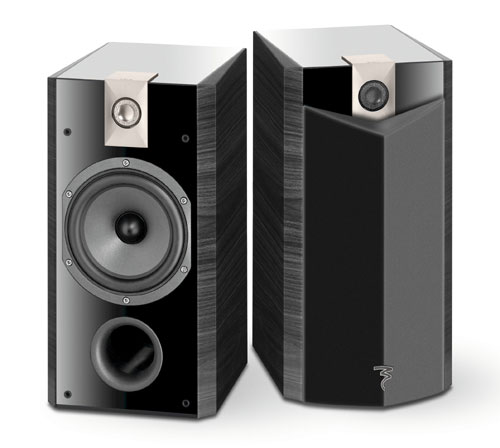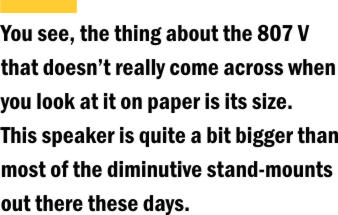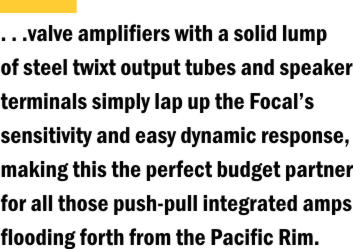Focal • Chorus 807 V Loudspeakers
ver wondered why British hi-fi buyers of a certain age cling so resolutely to the concept of PRAT ("pace, rhythm and timing," to the uninitiated)? Well, it’s got a lot to do with the wave of Flat Earth Evangelism that swept the country on the coattails of the Linn-Naim revolution, a retail movement that raised foot-tapping single-speaker demonstrations to an almost quasi-religious level -- complete with demonstrators/acolytes who twitched and gyrated in a weird St. Vitus dance, a public display of devotion to the god of musical involvement. Yep, PRAT was the word -- and prat was definitely the word. The self-fulfilling circular logic of the argument had a lot to do with PRAT's appeal -- you always got an answer and it was always the same, making PRAT the perfect philosophical security blanket, which is one of the reasons it remains so firmly entrenched amongst retailers who grew up in that era; they just can’t let go. But the other reason is that PRAT actually worked -- at least where it mattered, which was with starter systems. Once customers bought in to the concept, they were pretty much hooked and landed.
How things have changed. Affordable, effective turntables soon dropped off the public radar, despite the best efforts of Rega and Pro-Ject, leaving us reliant on budget CD players of indifferent musical quality, while speakers have shrunk in size, losing internal volume, bass-unit diameter and overall efficiency along the way. They’ve become more awkward to drive and less satisfying to listen to. None of which is good, especially if we are expecting them to draw in the next generation of hi-fi enthusiasts. Even in an industry that shows such a bloody-minded reluctance to learn the lessons of the past, this constitutes self-delusion that borders on self-harm -- especially when the evidence is sitting right in front of us. On paper, there might be little to make Focal’s 807 V stand out from the two-way crowd -- other than the fact that at its $1199 price point most of the competition are floorstanders. That makes it look quite expensive when compared to all those nice, neat, narrow little columns. You know, the ones with tiny bass drivers and side walls whose long dimension is just long enough to make their resonant frequency really musically intrusive. In fact, if you look at the bottom end of most speaker ranges these days, as the price goes up the cabinet goes down -- in this case, to the floor -- same drivers as the miniature stand-mount, just in a longer box. The next step after that? Add another of those dinky little bass drivers, why don’t you?
ut it’s not until you hook the 807 V's up that you really appreciate the importance of the specs. Music through these speakers has an immediately engaging mix of enthusiasm and intent. The bass just about claws its way down to that all-important 50Hz point, after which you don’t notice what’s not there unless it is. What’s more important is the style in which it does it. This speaker allows bands, their performance, the music they make, to really breathe. No pinched, over-damped and underwhelming bottom end here. Instead, if anything, Focal have backed off and given the speaker its head, a policy that more than makes up in expressive freedom and low-frequency impact what it loses in the last ounce of definition. It also acts to balance the speaker’s extended top end, a high-frequency range that is astonishing for its clarity and detail, but which otherwise might be left sounding a little obvious and exposed. Instead, and like all the best speakers, the first impression you’ll get from the 807 V is that it’s very much all of a piece, carrying its enthusiastic response to the dynamic demands of the signal right across the range, all the way from the bottom to the very top. That’s not to say it’s without faults; there’s a thinning of the upper-mids that I’ll return to later, as well as a tendency to glassiness if overdriven -- although by then you’ll be going some with most material. But what really sets the 807 V apart from the budget herd (other than its size, shape and driver complement, that is) is the way it lets music breathe. Playing rhythmically challenging material, like Art Pepper’s Smack Up CD [Analogue Productions CAPJ 012], tunes where the placement and depth of the bass notes demands a perfect balance if they’re going to integrate properly with the piano, the Focals manage to hit their stride with the minimum of fuss, delivering enough weight and getting it in the right place to properly underpin the brass, providing both a convincing anchor and the necessary impetus and momentum to give shape and direction to the meandering horn solos. It’s a neat trick, indicative of a speaker with just enough bottom to satisfy, not enough to get itself into trouble. In fact, even the excessive dynamic demands of Steve Earle’s Copperhead Road (LP, [MCA MCF3426]) are delivered with surprising aplomb (and a gratifyingly weighty thud) while the hitch-kick rhythms and hesitations that typify this and the likes of Gillian Welch are navigated with an uncomplicated sense of sure-footed ease -- almost as if the speaker is asking, "What, that’s supposed to be tricky?" Sure, you don’t quite get that last ounce of anticipation and drama, but musically it still hits a pretty convincing note. It is this combination of weight and agile dynamic response that enables the 807 V to conjure a feeling of life and purpose from even the blandest of modern recordings. At the same time, the sheer transparency and extension at the top end will let you hear all too clearly when a recording strays into bright, hard or splashy territory. Leslie Feist’s Metals [Polydor 277912-2] is a case in point: whoever equalized her voice wants shooting. "Great songs poorly served" is a common refrain, and the 807 V's leave you in no doubt that it applies with a vengeance here. It’s not the speaker doing the damage, but you need to be careful that you don’t shoot the messenger. Yes, they’re honest -- but not brutally so, unless provoked, and if that’s the case you are probably better off knowing anyway. It’s the other end of the recorded spectrum that reveals not so much the Focal’s failings as the way it tailors the sound. Really well-recorded music, like the Julia Fischer performance of the Mozart Sinfonia Concertante on PentaTone SACD [PentaTone PTC 5186 098], reveals that dip in the balance that can leave the upper-mids sounding a shade thin. Here, it robs the viola of some of its characteristic woodiness, yet at the same time gives a heightened sense of space and focus. The orchestra is beautifully spread, the acoustic full of air and height, while in this case the soloists, so often separated by tone, are actually more clearly separated in space. The performance has a lovely sense of articulation and rhythmic gusto, direction and structure, bringing a surprising clarity and integrity to the conversation between the solo instruments. The result is spectacular, even if it strays slightly from the truth.
or first-time buyers, or those looking for a second system, the Focal 807 V's might not seem like a particularly attractive option. Bulky and needing stands, which add to their ultimate cost, they might not seem like much of a deal -- until you listen to them. Once you hear just how effortlessly they embrace the task of reproducing music, especially compared to the competition at anything like the price, you’ll appreciate just what a bargain they represent. Like all great budget speakers they’ll grow with a system as upgrades are made, and just as they can reveal the shortcomings in a substandard setup, they’ll clearly reveal the benefits from even exotic partners. At one point and just for the hell of it, I hooked them up to VTL MB-450 Signature III amps, and a mighty fine time was had by all! Interestingly, if you compare the cost of equivalent products on a then-and-now basis, they look even better. When I was looking for a first system, the KEF Coda II cost £100, while the LS3/5a and Spendor SA1 both weighed in at £210. The current version of the SA1 now costs £1400, with the last price I could find for the '3/5a being around £900, back in 2008 -- and for what should be an absolutely identical speaker! So, price-wise, the 807 V, at £686, has pretty much kept step with those industry benchmarks. Now compare the standards of engineering and fit'n'finish between the KEF and Focal models. The vinyl-wrapped chipboard of the older speaker really doesn’t come close, while driver technology (and performance) has come a long, long way. Yet, listening to the Focal, it’s impossible to
ignore the fact that it’s doing essentially the same job as the KEF, just better.
What fascinates me about the Focal 807 V is not just that it’s a blast from the past
(or a throwback, if you are feeling less than charitable), but that it acts almost like a
signpost, showing exactly where it all started to go wrong. Back in the day, those starter
systems really did deliver, which is exactly what the 807 V does. It really is
all about the music, and the 807 V might even remind you that hi-fi should be fun too.
|


 You see, the thing about
the 807 V that doesn’t really come across when you look at it on paper is its size.
This speaker is quite a bit bigger than most of the diminutive stand-mounts out there
these days. But more important, that broader baffle sports a much larger bass-mid unit --
in this case a 7" polyglass-cone unit that does a pretty similar light-and-stiff job
to the paper cones of yore. Coupled to a 1" aluminum/magnesium-alloy inverted-dome
tweeter and loaded with a generous port, it is very much the living, breathing, high-tech
reincarnation of those speakers so many of us first cut our teeth on. One look at the
numbers and you’ll see what I mean. The 50Hz to 28kHz ±3dB bandwidth might not seem
particularly stentorian until you connect it with the 92dB sensitivity and 4.2-ohm minimum
load -- with a benign enough impedance characteristic to encourage the driving
amplifier rather than give it a hard time.
You see, the thing about
the 807 V that doesn’t really come across when you look at it on paper is its size.
This speaker is quite a bit bigger than most of the diminutive stand-mounts out there
these days. But more important, that broader baffle sports a much larger bass-mid unit --
in this case a 7" polyglass-cone unit that does a pretty similar light-and-stiff job
to the paper cones of yore. Coupled to a 1" aluminum/magnesium-alloy inverted-dome
tweeter and loaded with a generous port, it is very much the living, breathing, high-tech
reincarnation of those speakers so many of us first cut our teeth on. One look at the
numbers and you’ll see what I mean. The 50Hz to 28kHz ±3dB bandwidth might not seem
particularly stentorian until you connect it with the 92dB sensitivity and 4.2-ohm minimum
load -- with a benign enough impedance characteristic to encourage the driving
amplifier rather than give it a hard time. It’s this musical
coherence that characterizes the Focal, a balance and shape that in almost all cases seems
to trump any tonal liberties. The microdynamic definition and the vibrant quality that
goes with it allow voices to really sing. Whether it’s Janis Ian on "Some
People’s Lives" or Shawn Colvin singing "Shotgun Down the Avalanche,"
there’s an almost translucent delicacy to the vocals, a poise and definition that
clearly defines the difference between Leontyne Price singing a sultry Donna Leonora (from
La Forza) and the absolute precision and control of Milanov in the same role.
It’s a degree of quality and insight that belies the modest price of the speaker. It
also demands a little care in matching, with underpowered partnering amplifiers that
exhibit a tendency to thinness best avoided. On the other hand, valve amplifiers with a
solid lump of steel twixt output tubes and speaker terminals simply lap up the
Focal’s sensitivity and easy dynamic response, making this the perfect budget partner
for all those push-pull integrated amps flooding forth from the Pacific Rim. A quality
speaker will always demand a quality front-end. Fortunately that’s not too difficult
to achieve, although not surprisingly (and just like its spiritual forebears) the 807 V
stepped up yet another notch when fed from an analogue source. The VPI Classic, Groove+
and Icon Audio Stereo 60 Signature achieved a staggering level of musical engagement and
sheer enjoyment when coupled with the (not quite so) little Focals.
It’s this musical
coherence that characterizes the Focal, a balance and shape that in almost all cases seems
to trump any tonal liberties. The microdynamic definition and the vibrant quality that
goes with it allow voices to really sing. Whether it’s Janis Ian on "Some
People’s Lives" or Shawn Colvin singing "Shotgun Down the Avalanche,"
there’s an almost translucent delicacy to the vocals, a poise and definition that
clearly defines the difference between Leontyne Price singing a sultry Donna Leonora (from
La Forza) and the absolute precision and control of Milanov in the same role.
It’s a degree of quality and insight that belies the modest price of the speaker. It
also demands a little care in matching, with underpowered partnering amplifiers that
exhibit a tendency to thinness best avoided. On the other hand, valve amplifiers with a
solid lump of steel twixt output tubes and speaker terminals simply lap up the
Focal’s sensitivity and easy dynamic response, making this the perfect budget partner
for all those push-pull integrated amps flooding forth from the Pacific Rim. A quality
speaker will always demand a quality front-end. Fortunately that’s not too difficult
to achieve, although not surprisingly (and just like its spiritual forebears) the 807 V
stepped up yet another notch when fed from an analogue source. The VPI Classic, Groove+
and Icon Audio Stereo 60 Signature achieved a staggering level of musical engagement and
sheer enjoyment when coupled with the (not quite so) little Focals.